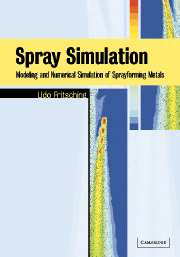Preface
Published online by Cambridge University Press: 10 August 2009
Summary
This book describes the fundamentals and potentials of modelling and simulation of complex engineering processes, based on, as an example, simulation of the spray forming process of metals. The spray forming process, in this context, is a typical example of a complex technical spray process. Spray forming, basically, is a metallurgical process whereby near-net shaped preforms with outstanding material properties may be produced direct from a metal melt via atomization and consolidation of droplets. For proper analysis of this process, first successive physical submodels are derived and are then implemented into an integrated coupled process model. The theoretical effects predicted by each submodel are then discussed and are compared to experimental findings, where available, and are summarized under the heading ‘spray simulation’. The book should give engineering students and practising engineers in industry and universities a detailed introduction to this rapidly growing area of research and development.
In order to develop an integral model for such technically complex processes as the spray forming of metals, it is essential that the model is broken down into a number of smaller steps. For spray forming, the key subprocesses are:
atomization of the metal melt,
dispersed multiphase flow in the spray,
compaction of the spray and formation of the deposit.
These subprocesses may be further divided until a sequential (or parallel) series of unit operational tasks is derived. For these tasks, individual balances of momentum, heat and mass are to be performed to derive a fundamental model for each.
- Type
- Chapter
- Information
- Spray SimulationModeling and Numerical Simulation of Sprayforming metals, pp. vii - ixPublisher: Cambridge University PressPrint publication year: 2004

